| Article ID | Journal | Published Year | Pages | File Type |
|---|---|---|---|---|
| 7615986 | Journal of Chromatography B | 2016 | 6 Pages |
Abstract
In this study, biosorption based dispersive liquid liquid microextraction (Bio-DLLME) has been developed as a new method for the extraction of bisphenol A (BPA) from water samples. In this technique, the BPA is extracted into a stable cloudy phase. The colloidal phase is composed of micro-particles made from rhaminolipid biosurfactant and methanol, which dispersed in the water samples and facilitated the breakdown of analyte matrix bonds and provided high extraction yields. Rhaminolipid biosurfactants form a thin molecular interfacial film. This layer is formed between donor and recipient phase. This molecular layer, lowers the interfacial tension between immiscible phases (aqueous solution: colloidal particles) and allow dissimilar phases to mix and interact more easily. So the equilibrium state is achieved quickly and, therefore, the extraction time is very short. The attraction of the proposed method is that the extraction is fast, simple and can be done without toxic organic solvents. Also bioaggregates have several advantages such as higher environmental compatibility and biodegradability. Experimental parameters affecting the extraction efficiency were studied and optimized. Under the optimum conditions, relative recoveries of BPA were in the ranges of 98-103.3%. The calibration plot is linear in the range between 1 and 1000 μg Lâ1 (R2 = 0.998), and the relative standard deviation (RSD, for n = 6) is 3.24%.
Keywords
Related Topics
Physical Sciences and Engineering
Chemistry
Analytical Chemistry
Authors
Seyed Ammar Haeri,
